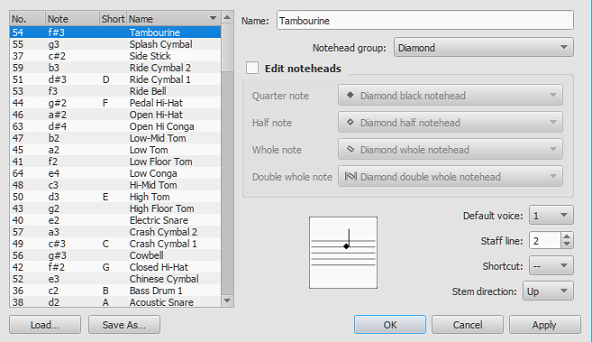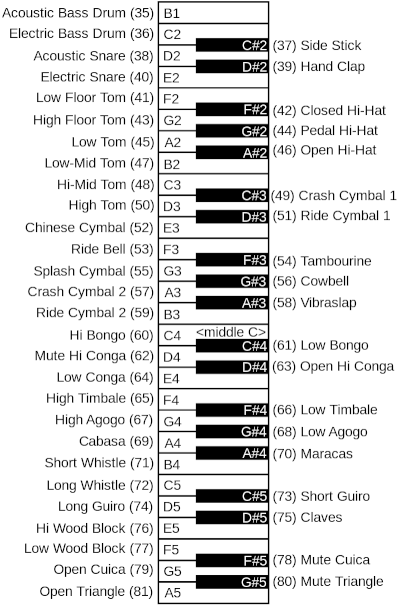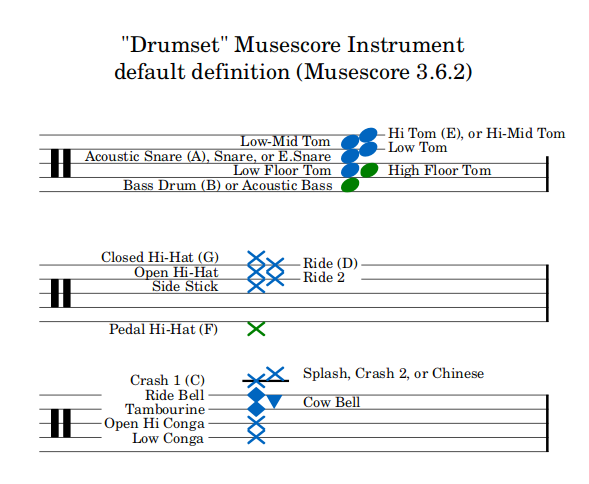Entering and editing percussion notation
Check out percussion input overhaul in Musescore 4.5
Overview

This chapter is applicable to percussion notation staff only.
Adding new staff is covered in Instruments, staff setup and templates. Instrument that use this notation are under "Percussion - Unpitched", "Percussion - Marching", and "Percussion - Body" groups. Note that some under "Percussion - Pitched" contain "Drums" in their name use standard notation: "Steel Drums", "Soprano Steel Drums", "Alto Steel Drums", "Guitar Steel Drums", "Tenor Steel Drums", "Cello Steel Drums", "Bass Steel Drums".
Changing staff template (percussion staff types, eg. 5-line, 3-line, or 1-line staff) is covered in Staff / Part properties.
Knowing why and how to use Musescore Voices before entering notes saves time. Notating concurrent rhythms and opposing stem directions on one staff are dependent on it. Note input method used affects new note's Voice. See also External links: Stem direction, staff space, note shape.
The free MuseScore Drumline (MDL) extension offers even more options to write percussion notation. To download and install it, see the Language, translations, and extensions chapter.
Real world instruments (sound samples) in a Musescore Instrument
A percussion Musescore Instrument contains real world instrument(s) (sound samples),
- "Drumset" under "Percussion - Unpitched". This is a single item that contains "Snare", "Bass Drum", "Ride Cymbal" etc sounds. There is no seperate MuseScore Instrument for each of these. Its default notation is covered under the "Note staff space" section.
- "Concert Bass Drum" under "Percussion - Unpitched" contains several sounds, it is not the "Drumset" 's "Bass Drum", and
- "Bass Drum" under "Percussion - Marching" contains several sounds, it is not the "Drumset"'s "Bass Drum".
Some are accessible with Mixer,
- "Drumset" "Standard 1" and variations, (same for "Room", "Power", "Jazz" and theirs), use them by changing Mixer: Sound.
- "Drumset" "Brush" and variations, use them by changing Mixer: Sound. Short brush is incorrectly titled "Electric Snare" in drum input palette.
- etc
Consider sound sample playback desired before note entry. Musescore does not have intuitive sound sample switching for existing notes, eg play "Ride Cymbal" sound sample with "Hi-hat" notes already entered, because internal references are added onto notes (MIDI pitch data). Switching the whole Musescore Instrument might damage note playback because the referencing method is Instrument specific. "Drumset" Musescore Instrument sound sample data cannot be added, removed, or edited inside Musescore.
Note input
User essentially enter notes and rests onto either,
- input cursor (see Note input mode chapter), or
- available time position, which is
- any existing note or rest (to create more, break down existing rest by adding new, shorter rest (right click or 0 (zero) as explained below), or
- the first beat of a measure.
Mouse entry using the Drum input palette
To add a note at input cursor,
- Select a measure, note or rest.
- Enter note input mode (shortcut N). The Drum input palette now appears at the bottom of the screen (see "Drum input palette" section). The Voice of the note to be added is indicated by note color in Drum input palette : blue for Voice 1, green for Voice 2. Top Toolbar Voice selection is ignored.
- Select note value at the top Toolbar.
- Double-click an item in the Drum input palette. Existing notes and rests are overwritten.
- The note input cursor position proceeds forward.
To add a note or rest at any available time position,
- Select the staff.
- Enter note input mode (shortcut N). The Drum input palette now appears at the bottom of the screen (see "Drum input palette" section). The Voice of the note to be added is indicated by note color in Drum input palette : blue for Voice 1, green for Voice 2. Top Toolbar Voice selection is ignored.
- Depending on the result desired, select an appropiate note value at the top Toolbar and item in the Drum input palette:
- Rests are always overwritten by notes.
- Any existing notes are retained if note value matches. A notation similar to a chord is created.
- Otherwise the new note overwrites (or truncates) the existing note.
- Notes and rests of different Voice do not affect each other.
- Left click on a desired time position on the score to add a note. Right click to add a rest.
Using keyboard shortcuts
To add a note or rest at input cursor,
- Select a measure, note or rest.
- Enter note input mode (shortcut N). The Drum Input palette now appears at the bottom of the screen.
- Select note value at the top Toolbar.
- Enter note with A–G displayed in the Drum Input palette (
shortcut assignment see "Drum input palette" section). Enter rest with 0 (zero). The new note uses the Voice indicated by note color in Drum input palette : blue for Voice 1, green for Voice 2 (Top Toolbar Voice selection is ignored). If there is no note on the Voice, input cursor repositions itself to beat 1 of measure. Existing notes and rests are overwritten. - (Optional) Add another note to an existing one with Shift+[A–G]. This note uses the Voice the last note is using, but not the setting indicated on Drum input palette.
- The note input cursor position proceeds forward.
MIDI controller
To add a note at input cursor,
- Configure the MIDI controller. See Preferences.
- Select a measure, note or rest.
- Enter note input mode (shortcut N).
- Select a Voice and note value at the top Toolbar. Drum input palette Voice and Stem direction settings are ignored.
- Press a MIDI controller key.
- (Optional) To add another note to an existing one, keep the first key held down while pressing the second key.
Virtual piano keyboard
To add a note at input cursor,
- View → Piano keyboard (P) to show the virtual piano keyboard.
- Select a measure, note or rest.
- Enter note input mode (shortcut N).
- Select a Voice and note value at the top Toolbar. Drum input palette Voice and Stem direction settings are ignored.
- Click a key on the virtual piano.
- (Optional) Add another note to an existing one with Shift + click another key.
To adjust virtual piano keyboard panel's position, drag and drop its title bar
- on to the center of Drum input palette panel. Both panels can then be accessed by Tabs; or
- to either side of Drum input palette panel.
Drum input palette

Drum input palette is displayed at the bottom of the screen when,
- a percussion staff is selected, and
- it is currently in note input mode (shortcut N).
Palette items (button with note symbol) are used to enter new notes with mouse or keyboard shortcuts. Each represents a sound sample. Position the mouse pointer over any to view its name. Text (A to G) shown are keyboard shortcuts. They do not refer to note pitches.
The Edit Drumset window

Do not be confused by the wording "Edit Drumset". User cannot edit Musescore Instrument data inside Musescore. See "sound samples" section.
Use "Edit Drumset" window to edit
- existing notes of the selected staff (Notehead group and its related settings, and Staff line), and
- "Drum input palette" items, which are used to enter new notes with mouse or keyboard shortcuts (all settings).
To open,
- Click Edit Drumset button on the left of the Drum input palette; or
- Right-click a staff and select Edit Drumset....
Use the left pane to select a sound sample,
- No.: the MIDI pitch data utilized internally, reference of sound sample used to create audio.
- Note: the MIDI pitch data utilized internally, reference of sound sample used to create audio.
- Shortcut: see below.
- Name: see below.
Use the right pane to edit how notes using selected sound sample is displayed on the score.
- Name: For display on Drum input palette only. Leave empty to remove from Drum input palette.
- Notehead group, Edit Noteheads and sub-settings: See the "Notehead shape" section. Affects existing notes of selected staff.
- Default voice: Voice assigned to new note entered with mouse or keyboard shortcut only. See "Voice" section.
- Staff line: The staff line / space on which the note is displayed. Value 0 means that the note is displayed on the top line of the 5-line staff. Enter negative values to move upwards. Affects existing notes of selected staff. See also "Staff space" section.
- Shortcut: Keyboard shortcut.
- Stem Direction: Stem direction note property assigned to chord of new note entered with mouse or keyboard shortcut only. See also "Stem direction" section.
Use Save As... and Load... to save and load "Edit Drumset" window settings to external .drm file. See also files under External links.
Drum map and Test out sound samples
Refer to a General MIDI Level 2 (GM2) percussion key map (drum map) for each sound sample's corresponding key (pitch). TO demo sound sample on MIDI controller or vitual piano keyboard, use normal mode (ESC).

Voice
See also the main chapter Voices.
Notating concurrent rhythms and opposing stem directions on one staff are dependent on using Voices. Automatic stem direction assignment of any chord can be overridden.
The Voice assigned to new note depends on input method used, which is either
- the "Drum input palette" item Default voice property in case of mouse or keyboard shortcut note entry; or
- the Toolbar button selected otherwise.
Stem direction
Stem direction is automatically assigned according to Voice, and can be manually overridden with Stem direction note property.
Edit Drumset window : Stem direction property is assigned to new note entered with mouse or keyboard shortcut. It is completely ignored in note entry using MIDI controller and virtual piano keyboard.
Staff space

drumsetdefaultdef3.mscz
Shown above "Drumset" default definition.
Change staff line / space / vertical position of all notes on the currently selected staff with Staff line explained in "Edit Drumset" section. Advanced users can override with Fix to line note property (an absolute position).
Notehead shape
Use "cross", "ghost note" or "dead note", by editing Notehead group and Edit Noteheads as explained in "Edit Drumset" section. No individual note overriding option available.
Brackets (parentheses, dead note or ghost note) and "open circle" (additional symbol) can be added to individual notes from palettes. They do not affect playback. Add brackets from Noteheads and "open circle" from Articulation.
Other notations
Sticking
To enter sticking symbols (R, L):
- Select a start note;
- From the menu, select Add→Text→Sticking. Alternatively, set up a keyboard shortcut to do the same thing in Preferences;
- Input the symbol just as you would normal text. To move forward or backwards to the next note, use the same keyboard shortcuts as for chord symbols.
- To exit, press Esc, or click on a blank section of the score.
Add drum roll
To create a drum roll, use a Tremolo.
External links
- How to create jazz drum notation [MuseScore How-To]
- Video tutorial: MuseScore in Minutes: Lesson 7 - Tablature and Drum Notation
- Drum Parts [video]
- Editing the Drum Palette in MuseScore 1.1 [video]
- Saving Drumset Changes in MuseScore 1.1 [video]
- Notation standards
- Drum magazine reference chart (June 2007) http://musescore.org/sites/musescore.org/files/Drum_Notation_Chart.jpg
- Sibelius http://musescore.org/sites/musescore.org/files/notation_drumset_en.png , based on the recommendations of the Percussive Arts Society found in Norman Weinberg’s Guide To Standardized Drumset Notation (2002, ISBN 0-9664928-1-1)
- A french drumset, Nicolas http://musescore.com/nicolas/scores/35344 , based on discussion http://musescore.org/fr/node/14340#comment-49750 and loosy based on the Dante-Agostini method https://musescore.org/sites/musescore.org/files/Image%2010.png
- Guide to Drum and Percussion Notation
- Stem direction, staff space, note shape
- stem direction
- "hands up, feet down" and others in Better drumset notation (with focus on stem direction) forum discussion,
- "pulse and rhythm" rule https://www.onlinedrummer.com/blogs/drum-lessons/introduction-to-voicin….
- staff line / space / vertical position denotes the instrument (sound sample). Programatically, "MIDI pitch" stores sound sample reference in Musescore 3.6.2 - open and closed hi-hat on different space.
- note shape usually denotes pitch (or pitchless) in music sense.
- stem direction
- Drm files
- https://musescore.org/fr/node/14340
- https://musescore.org/en/node/81636
- Weinberg's Standardized Drumset Notation in Musescore, @RunasSudo, Apache Licence 2.0. https://yingtongli.me/blog/2020/06/24/weinberg-musescore.html